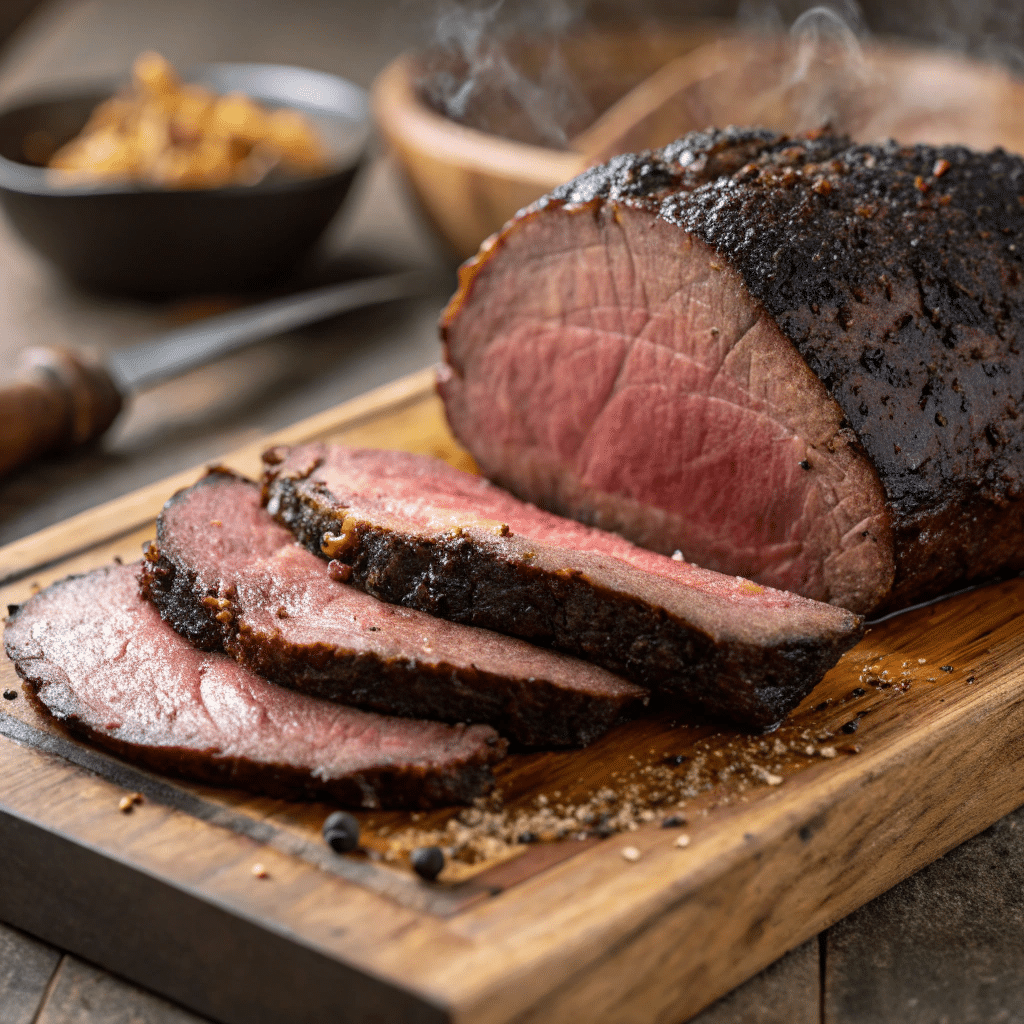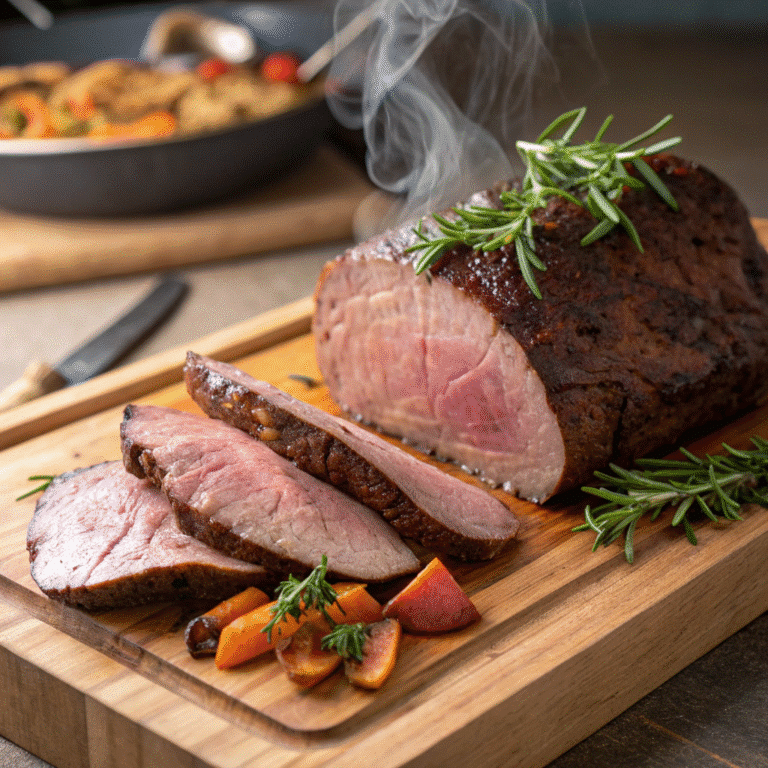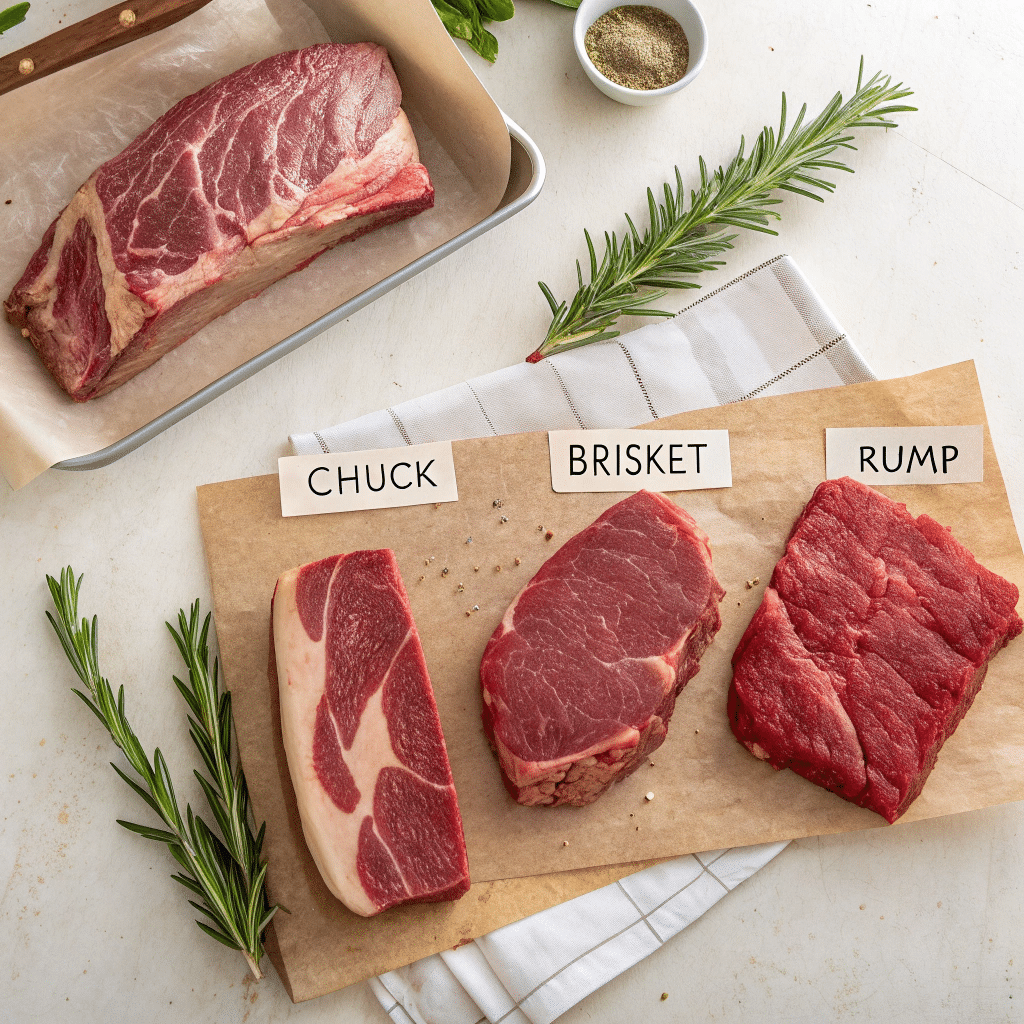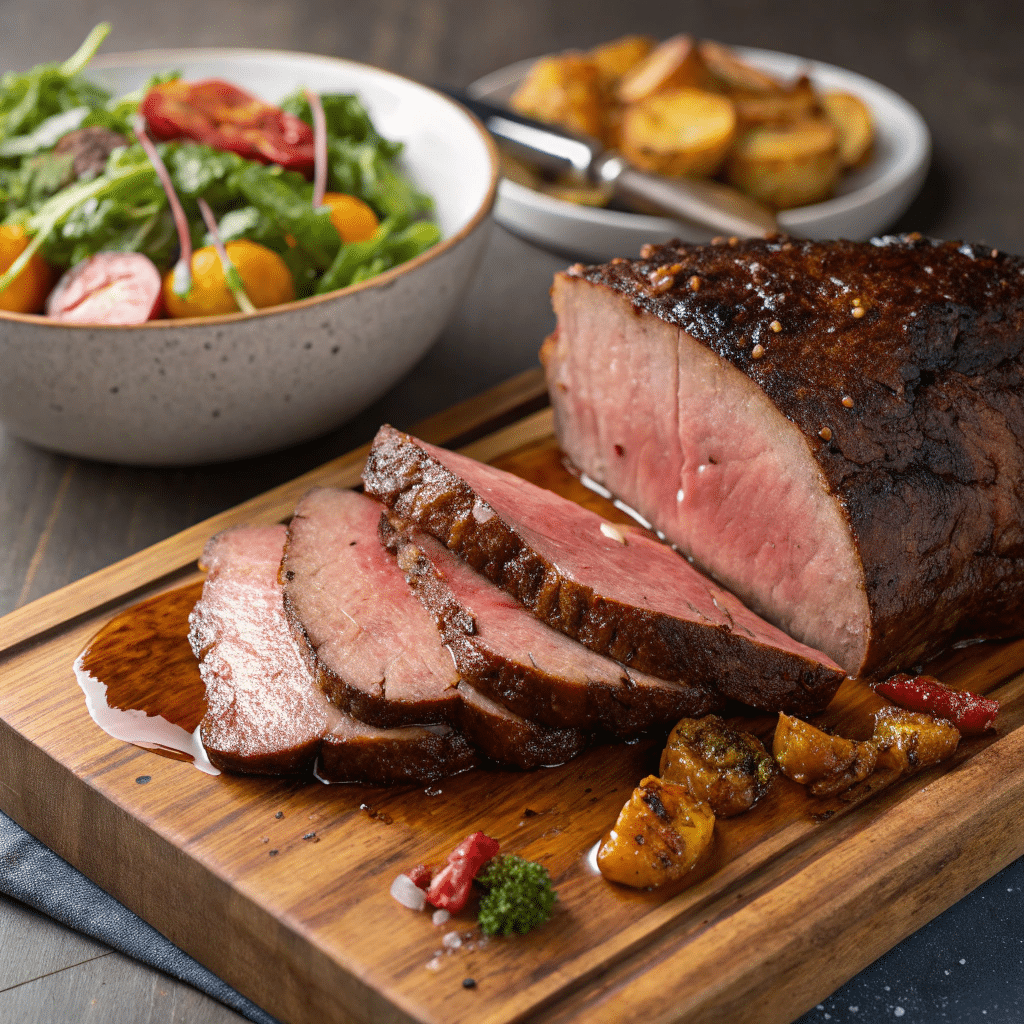Smoked beef roast is one of those backyard BBQ classics that transforms a simple cut of meat into a smoky, juicy, fall-apart masterpiece. Whether you’re a weekend grill warrior or a total beginner, mastering the art of smoking beef roast at home doesn’t require fancy equipment or culinary school training. All it takes is the right cut, a bit of patience, and a well-seasoned smoker.

In this complete guide, we’re diving deep into how to choose the right beef cut, season it for maximum flavor, and smoke it low and slow to juicy perfection. You’ll learn everything from the best wood chips to use to how to slice your roast without losing a drop of that smoky goodness. We’ll also cover the essential temperatures for safety and doneness, common mistakes to avoid, and creative ways to serve your leftovers.
Looking for inspiration? Try our Smoked Turkey Leg Recipe for another delicious smoked dish.
Print
Smoked Beef Roast
This smoked beef roast comes out incredibly tender and juicy, packed with rich, smoky flavor in every bite. With the right rub, low-and-slow smoking method, and the perfect internal temperature, this is the ultimate roast recipe for your next BBQ, Sunday dinner, or family gathering
- Total Time: 6 hours 15 minutes
- Yield: 6 servings 1x
Ingredients
3–5 lb chuck roast (or brisket, rump roast)
2 tbsp kosher salt
1 tbsp black pepper
1 tbsp garlic powder
2 tsp smoked paprika
1 tbsp brown sugar
½ tsp cayenne pepper (optional)
Wood chips (hickory, oak, or mix)
Apple juice or broth (for spritzing)
Instructions
Trim excess fat and pat roast dry.
Mix all dry rub ingredients and coat the beef roast generously.
Let it rest for at least 1 hour (or refrigerate overnight).
Preheat smoker to 225°F. Add wood chips of your choice.
Place the roast in the smoker, fat side up. Insert a meat probe if available.
Smoke for 4–6 hours, spritzing every hour with apple juice or broth.
When internal temperature reaches 195°F–205°F, remove and wrap in foil. Rest for 30 minutes.
Slice or shred, and serve hot.
Notes
For sliced roast, pull at 145°F. For shreddable texture, smoke until 200°F+
Leftovers make amazing sandwiches and tacos
Marinate 24 hours ahead for deeper flavor
- Prep Time: 15 minutes
- Cook Time: 6 hours
- Category: Main Dish
- Method: Smoking
- Cuisine: American BBQ
- Diet: Gluten Free
Nutrition
- Calories: 425 kcal
- Sugar: 1g
- Sodium: 820mg
- Fat: 30g
- Saturated Fat: 12g
- Unsaturated Fat: 16g
- Carbohydrates: 3g
- Fiber: 1g
- Protein: 38g
- Cholesterol: 115mg
Whether you’ve got a pellet smoker, charcoal grill, or electric smoker, this guide will walk you through every step to make your smoked beef roast the star of your next cookout. Let’s fire up that smoker!
Table of Contents
Introduction to Smoked Beef Roast
What is a Smoked Beef Roast?
Smoked beef roast is a hefty cut—often chuck, brisket, or round—slow-cooked in a smoker to develop deep, rich flavor over time. The process infuses the meat with deep smoky flavor while gradually breaking down connective tissue, resulting in a tender, flavorful roast with a caramelized crust known as the “bark.”
Unlike oven roasting, smoking not only cooks the meat but also enhances the flavor profile using wood smoke. The end result? A flavorful, tender, and smoky sensation that shines in sandwiches, stands out on plates, or steals the show as the star of any barbecue spread.
Why Smoking Enhances Flavor and Texture
When beef roast is smoked at a low temperature (usually between 225°F–250°F), two things happen:
- Flavor infusion: Wood smoke adds aromatic compounds that penetrate the outer layer of the meat, creating a deep, savory taste you can’t replicate with other cooking methods.
- Tenderization: Collagen in the beef slowly breaks down into gelatin over several hours, making even tougher cuts melt-in-your-mouth tender.
This method allows even budget-friendly cuts to become luxurious, restaurant-quality dishes at home. Don’t miss our guide to Smoked Salmon Brine for another way to infuse deep flavor into protein.
Smoking beef roast is also ideal for meal prepping because it stores and reheats well. You can use leftovers in tacos, wraps, or sliders—adding more value with every bite.
Next up, we’ll explore the best beef cuts for smoking so your meat starts off with the best chance of greatness.
Choosing the Best Cut for Smoking Smoked Beef Roast
Top Cuts for Smoking Smoked Beef Roast (Chuck, Brisket, Rump, etc.)
Choosing the right beef cut is the foundation of a flavorful smoked beef roast. Not all roasts respond the same way to smoke, so selecting a cut with natural marbling and connective tissue will give you the tender, juicy results you’re after.

Here are the top cuts recommended for a perfect smoked beef roast:
| Cut Name | Flavor Profile | Texture After Smoking | Notes |
|---|---|---|---|
| Chuck Roast | Rich, beefy | Tender, shreddable | Most common cut for smoked beef roast |
| Brisket | Deep, smoky, intense | Buttery when cooked right | Classic Texas-style smoked beef |
| Rump Roast | Mild, leaner | Slightly firmer texture | Slices well for smoked beef sandwiches |
| Top Round | Lean, less marbled | Chewy if overcooked | Benefits from brining or injecting |
The chuck roast stands out as the most popular option for home-smoked beef roast recipes. It’s budget-friendly, easy to find, and reliably turns out tender and juicy every time. For a next-level smoking experience, go with brisket—renowned as the ultimate cut for rich, tender beef infused with bold, smoky flavor.
Looking for inspiration? Try our recipe for Smoked Turkey Leg—it follows many of the same principles and flavors as a smoked beef roast.
Bone-In vs. Boneless: What’s Better for Smoking Beef Roast?
Both bone-in and boneless cuts work well, but each brings its own advantage. Smoking a bone-in beef roast helps lock in moisture and adds a rich depth of flavor as the marrow slowly infuses the meat. On the other hand, a boneless smoked beef roast cooks more evenly and is easier to slice, especially when serving a crowd.
Tip: No matter the cut, make sure your smoked beef roast weighs at least 3 to 4 pounds to handle low-and-slow cooking without drying out. If your smoker fits larger cuts, go bigger for more leftovers and better smoke absorption.
Don’t miss our guide to Smoked Salmon Appetizer for more smoked recipes that impress.
Preparing Your Smoked Beef Roast for the Smoker
Trimming, Tying, and Marinating Tips
Before your smoked beef roast hits the smoker, a little prep goes a long way. Start by trimming excess fat, especially any thick, hard layers that won’t render down. Leave a thin fat cap—around 1/4 inch—for added moisture and flavor.
If the roast is loosely formed, secure it with butcher’s twine to keep it tight and uniform. This ensures even cooking and helps the roast maintain its shape.
Marinating adds extra flavor and tenderness. For a rich, smoky result, try:
- Acidic bases: apple cider vinegar or Worcestershire
- Flavor boosts: garlic, soy sauce, onion powder
- Oil-based marinades: olive oil + herbs for leaner cuts
Let it sit overnight in the fridge for full flavor penetration.
Dry Rubs vs. Wet Marinades: Which Works Best?
When it comes to smoked beef roast, either method works—but dry rubs are the classic choice for creating that signature smoky bark. A good rub sticks, caramelizes, and forms flavor-packed edges.
Common dry rub ingredients:
- Salt + black pepper (essential base)
- Garlic + onion powder
- Smoked paprika for depth
- Brown sugar for a hint of sweetness
Use a dry rub if you want that signature crust. Wet marinades are better for leaner cuts like top round, where moisture retention is key.
Quick Tip: Combine both methods—marinate for a few hours, then apply a dry rub before smoking for bold layers of flavor.
The Best Wood Chips and Smoke Flavors for Smoked Beef Roast
Hickory, Mesquite, Oak, and Fruitwoods Explained
The wood you use directly shapes the flavor of your smoked beef roast. Each type gives a unique smoke profile, so picking the right one matters.
Here’s a quick breakdown:
| Wood Type | Flavor Strength | Best Use For Smoked Beef Roast |
|---|---|---|
| Hickory | Strong, bacon-like | Bold cuts like chuck or brisket |
| Mesquite | Intense, earthy | Short smokes or spicy rubs |
| Oak | Medium, balanced | All-purpose for beef roast |
| Apple/Cherry | Mild, slightly sweet | Great with peppery dry rubs |
Hickory and oak are go-to choices for beef. They’re bold but not overpowering. For a hint of sweetness, blend in some applewood to create a well-balanced flavor profile.
Matching Wood to Marinade and Seasoning Profiles
Think of wood like a seasoning. Pair mesquite with a basic salt and pepper rub to deliver a bold, smoky kick. Pair applewood with brown sugar or fruit-based marinades for sweeter flavor.
Mixing woods works too. Try oak with a little cherry for a smoky-sweet combo that complements almost any smoked beef roast recipe.
Step-by-Step: How to Smoke a Beef Roast at Home
Setting Up Your Smoker for Consistent Heat
Getting your smoker ready is key to a tender, flavorful smoked beef roast. Set the temperature to 225°F–250°F, the sweet spot for low and slow cooking. Keep your smoker at 225°F to 250°F—ideal for that low-and-slow perfection. No matter if you’re using a pellet grill, charcoal smoker, or electric unit, consistent heat and clean smoke are key.
Here’s a quick setup guide:
| Smoker Type | Setup Tips |
|---|---|
| Pellet Grill | Fill hopper with wood pellets, preheat |
| Charcoal Smoker | Use indirect heat + water pan |
| Electric Smoker | Add wood chips, set digital temp |
Placing a water pan in the smoker helps regulate moisture and maintain steady temperatures throughout the cook. This keeps the smoked beef roast from drying out during those long cook times.
Smoking Times, Temperature, and Pro Tips
The average smoke time for a 3–5 lb beef roast is 4 to 6 hours, depending on the cut and your target doneness. Always use a meat thermometer—that’s non-negotiable.
Internal temperature guide:
- Rare: 125°F (not ideal for smoking)
- Medium Rare: 135°F
- Medium: 145°F (ideal texture)
- Well Done: 160°F+ (good for shredded beef)
Want a fall-apart smoked beef roast? Take it to 195°F–205°F. That’s the point where collagen melts, transforming the meat into a tender, juicy bite.
Pro Tips:
- Don’t peek too much—opening the smoker drops heat fast.
- Spray with apple juice or broth every hour to keep it moist.
- Allow the roast to rest for a minimum of 30 minutes before slicing to lock in the juices.
Seasoning Secrets for the Perfect Bark on Smoked Beef Roast
Salt, Pepper, Garlic, Paprika… and Beyond
The secret to a mouthwatering smoked beef roast? A good seasoning rub. A dry rub forms a bold crust—crackling, richly charred, and infused with deep, smoky intensity.
Start with the basics:
- A bold duo of kosher salt and cracked black pepper forms the backbone of a perfect crust.
- Garlic powder – adds rich, savory notes
- Smoked paprika – boosts smoky flavor and color
- Brown sugar – for sweetness and caramelization
For an extra kick, try mixing in a dash of onion powder, cayenne, or a hint of mustard powder. Mix everything and coat the entire roast generously, pressing the rub into every surface.
How to Create a Flavor-Packed Rub at Home
Try this one-of-a-kind homemade rub recipe perfect for smoked beef roast:
| Ingredient | Amount |
|---|---|
| Kosher salt | 2 tbsp |
| Black pepper | 1 tbsp |
| Garlic powder | 1 tbsp |
| Smoked paprika | 2 tsp |
| Brown sugar | 1 tbsp |
| Cayenne pepper | ½ tsp |
Combine, rub it on the meat, and let it sit for 1 hour (or overnight for deeper flavor).
Monitoring Temperature for Safety and Tenderness in Smoked Beef Roast
Internal Temperature Guide by Doneness
Knowing when your smoked beef roast is done isn’t guesswork—it’s all about internal temp. Use a digital meat thermometer to avoid undercooking or drying it out.
Here’s a temperature chart for beef roast:
| Doneness | Internal Temp (°F) | Texture Result |
|---|---|---|
| Medium Rare | 135°F | Juicy and pink |
| Medium | 145°F | Tender, slight chew |
| Well Done | 160°F+ | Firmer, better for slicing |
| Pulled/Tender | 195–205°F | Fall-apart texture |
For classic sliced smoked beef roast, aim to pull it at 145°F, then let it rest to lock in the juices. If you’re going for a tender, fall-apart shredded style, keep cooking until it reaches at least 195°F.
Key Tip: After smoking, let the roast sit undisturbed for 20–30 minutes. This crucial resting time lets the juices settle back into the meat, enhancing both tenderness and taste.
Tools You Need: Probes, Thermometers & Apps
To stay in the safe zone:
- Give meat thermometer apps such as MEATER or ThermoWorks a try to get timely alerts.
- Try meat thermometer apps (like MEATER or ThermoWorks) for alerts.
- Keep a backup analog thermometer just in case.
Avoid over-smoke and temp drops by keeping the smoker lid closed and maintaining consistent heat.
Slicing, Serving, and Storing Smoked Beef Roast
How to Slice for Maximum Juiciness
Once your smoked beef roast has rested, it’s time to slice. Use a lengthy, finely honed carving knife and always cut perpendicular to the grain. This breaks down the muscle fibers, resulting in a more tender bite every time.

For sliced smoked beef roast, aim for ¼-inch thick cuts. If your roast was cooked to shredding temp (195°F+), simply pull it apart with two forks or shred using gloves while it’s still warm.
Pro Tip: Resting the roast under foil for 30 minutes helps lock in juices and makes slicing cleaner.
Leftover Ideas: Tacos, Sandwiches, and Bowls
Smoked beef roast leftovers are gold. Here’s how to use them:
- BBQ beef sandwiches with pickles and slaw
- Beef tacos with grilled onions and salsa
- Grain bowls with rice, black beans, and avocado
- Smoked beef hash for breakfast with eggs
Wrap leftovers tightly in foil or airtight containers. Keep refrigerated for up to 4 days or freeze for as long as 3 months. When reheating, add a little broth to keep it moist.
Common Smoking Mistakes and How to Avoid Them
Temperature Fluctuations
One of the biggest issues when making smoked beef roast is unstable temperature. Constant heat changes dry out the meat or leave it undercooked.
Avoid this by:
- Preheating your smoker properly
- Not opening the lid too often
- Using a probe thermometer to monitor internal temps
Keep your smoker in a wind-shielded area for better consistency.
Over-smoking or Under-seasoning
Too much smoke can overpower the flavor, making your smoked beef roast bitter. Using too little seasoning leaves it bland.
Avoid this by:
- Using only seasoned hardwoods (not green or overly resinous wood)
- Sticking to 4–6 hours of smoke for smaller roasts
- Applying a generous rub 1 hour before cooking
It’s also a mistake to skip resting the meat—resting is when the juices settle, giving you better texture and moisture.
Bonus Tip: Don’t forget to clean your smoker regularly. Accumulated ash and grease can disrupt both the taste and temperature consistency.
Frequently Asked Questions About Smoked Beef Roast
How do you smoke a beef roast at home?
To smoke a beef roast at home, start by seasoning it with a dry rub or marinade, then place it in a preheated smoker set to 225°F–250°F. Use hardwood chips like hickory or oak for strong, smoky flavor. Let the roast slowly smoke for 4 to 6 hours, adjusting the time based on its size and how well done you want it. Always monitor internal temperature using a meat thermometer, and let the roast rest for 20–30 minutes after smoking.
What temperature should a smoked beef roast reach?
That depends on how you want it cooked. For perfectly sliced smoked beef roast, target an internal temperature between 135°F and 145°F for a medium-rare to medium finish. If you want shredded beef, smoke it until it reaches 195°F–205°F, which breaks down connective tissue for that tender, fall-apart texture.
Is smoked beef roast tender or tough?
When smoked correctly, smoked beef roast is incredibly tender and juicy. Toughness usually results from undercooking or not letting the meat rest. Choosing the right cut—such as chuck or brisket—then smoking it low and slow and reaching the ideal internal temperature guarantees tender, flavorful results every time.
What are the best seasonings for smoked beef roast?
The best seasonings for a smoked beef roast are bold and simple. A classic rub includes kosher salt, black pepper, garlic powder, smoked paprika, and brown sugar. Add cayenne for a spicy kick, or toss in herbs like thyme to deepen the flavor. Let the seasoning rest on the roast for at least an hour—or leave it overnight to really intensify the taste.
Conclusion
Smoking a beef roast can be simple and straightforward. With the right cut, consistent temperature, and well-balanced seasoning, you can create a smoked beef roast that’s tender, flavorful, and full of character. Every stage—from prep and seasoning to slicing and plating—contributes to a roast that consistently delivers a crowd-pleasing finish.
Whether served in slices with your favorite sides, shredded into sliders, or repurposed into delicious leftovers, smoked beef roast remains a go-to favorite for home pitmasters across the board.
Follow us on Facebook at how to cooking recipes for daily recipe inspiration and kitchen tips.
